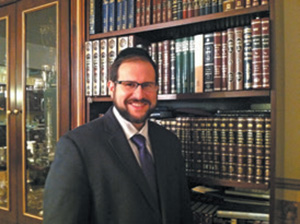
Last Friday, as President Trump took the podium at the Conservative Political Action Conference (CPAC), he noticed his own reflection on television and remarked that he would love to hear that guy speak. He then turned around and began fixing his hair, and announced: “I try… to hide that bald spot, folks, I work hard at it. We’re hanging in there folks—together we are hanging in.”
With that, he began his talk about more trivial matters, like politics and what he was really invited for.
In other news this week, Union College in Schenectady, New York, claims to have found a lock of George Washington’s hair inside a “long-forgotten book.” The book—a leather-bound almanac—is believed to have been owned by Philip J. Schuyler, son of General Philip Schuyler, who was a close friend of George Washington and served under him during the Revolutionary War.
The school says it is unsure how the almanac with the lock of hair inside ended up in their archives.
Hearing the two stories this week gave me an epiphany. I think President Trump should purchase the lock of Washington’s hair and use it to cover his bald spot. Not only would it cover his scalp, but he would be able to brag about the symbolism of his wearing the hair of the first president and leader of the United States. He would just have to dye the hair blond from its famous (natural) white color.
A Jewish comedian opined that the Jewish custom of men wearing yarmulkes came about because of paternal baldness. Some Jews were embarrassed by their bald spots so they covered it with a cloth. It caught on, and before long, all the Jewish men were wearing these hip “baldness covers.” It was the first Jewish innovation, even before the Shabbos Lamp and the Shayne Coat.
Chazal maintain a negative view toward one spending time fixing his hair. When the Torah refers to Yosef Hatzadik as a na’ar—youth, Rashi explains that it is in a negative connotation because he was too interested in his hair. Although he did so with noble intentions, reasoning that as a son of the great Yaakov Avinu he had to look presentable and dignified, it was too much, unbecoming of someone of Yosef’s stature.
The truth is that the word yarmulke is a contraction of two Aramaic words—Yarei Malka—Fear of the King. A Jew lives with the realization that he is always in the presence of the King of Kings, and lives his life based on certain expectations. The yarmulke is a constant reminder of his mission and higher calling in life.
When the evil Haman presented his plan to Achashverosh to solve the Jewish Problem through mass genocide, he preempted every possible rational argument about why it couldn’t be done. The gemara says that Haman reasoned to Achashverosh that killing all the Jews wouldn’t cause “a bald spot” within the kingdom because the Jews are scattered and spread out throughout the 127 countries that comprised his kingdom.
Part of Haman’s intention was to so frighten the Jews that they would be completely paralyzed by fear and unable to respond. His intentions were foiled when the nation rallied under the call of Esther to Mordechai to “go and gather all of the Jews.” Not only were they not paralyzed, but Haman was unwittingly responsible for the greatest mobilization of Jewish prayer and unity in history.
Ironically, the one who was destroyed by panic was Haman. When he approached Achashverosh in the middle of the night to garner permission to hang Mordechai, at that moment he was at the top of the world. From there onward, the events completely unraveled for him at such a dizzying pace that he was never able to catch his breath. A few hours later he was leading his archenemy through the streets. By the time it was over, his daughter was dead and he smelled putrid. He was rushed off to the party where Esther pointed out his culpability. Achashverosh’s anger kept rising until he lost his temper, and Haman was carted off to the gallows, literally without having a moment to think about what happened.
Haman claimed that killing the Jews would not create a bald spot because they are so scattered and diverse. The truth was that there was no bald spot because they bound together, internalizing the message of the yarmulkes perched upon their heads—symbolizing that there is a power stronger than Haman and Achashverosh.
The love and connection they felt at the time of the miracle returns to us every Purim. It is a holiday that unifies every Jew in love and friendship. At least for one day we remove the masks of enmity and divisiveness we often wear. We drown our emphatic opinions and hard-held beliefs, intoxicating ourselves with love and emotions that overcome all barriers.
Shoshanas Yaakov—the Rose of Yaakov, with its multihued resplendent colors, comes together with the joy of seeing the techeles, the tzitzis of Mordechai, as they peeked out from beneath the royal robes as he was being led through the streets of Shushan by Haman.
On Purim we recapture our pride in our tzitzis and yarmulkes and the modest dress of Jewish women. The world will never be “bald of Jews” for we will always wear our yarmulkes perched proudly upon our heads.
That powerful message resonates long after the physical holiday of Purim has reached its happy conclusion.
By Rabbi Dani Staum
Rabbi Dani Staum, LMSW, is the rabbi of Kehillat New Hempstead as well as a rebbe and guidance counselor at Heichal HaTorah in Teaneck, New Jersey, principal at Mesivta Ohr Naftoli of New Windsor and a division head at Camp Dora Golding. He can be reached at stamtorah@gmail.com. Looking for “instant inspiration” on the parsha in under five minutes? Follow him on Torahanytime.com.










